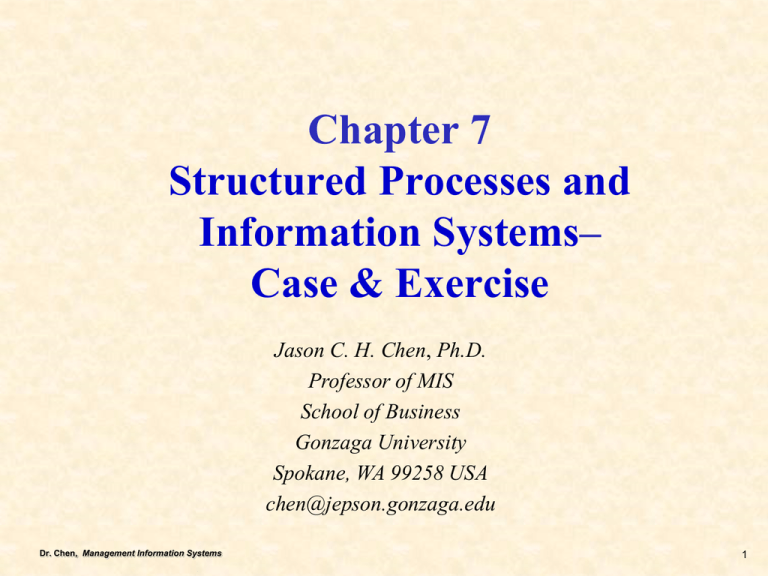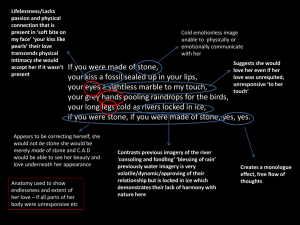ch07-Case - Gonzaga University
advertisement

Chapter 7 Structured Processes and Information Systems– Case & Exercise Jason C. H. Chen, Ph.D. Professor of MIS School of Business Gonzaga University Spokane, WA 99258 USA chen@jepson.gonzaga.edu Dr. Chen, Management Information Systems 1 USING YOUR KNOWLEDGE UYK#7(4 or 5)-p.251 • #5 (Fox Lake) • # 4 (Hospital) Dr. Chen, Management Information Systems 2 • 4.Using the patient discharge process in Figure 7-10, explain how the hospital benefits from an ERP solution. Describe why integration of patient records has advantages over separated databases. Explain the value of industry-specific ERP solution to the hospital. • • An integrated ERP solution will be very beneficial in the hospital setting. For patient discharge, the physician can use a discharge application that triggers processing in other related applications to accomplish all of the notifications outlined in Figure 7-5. Because the applications use an integrated database, there is little chance of anything being lost or overlooked. • If the discharge should get cancelled later, the integration is immediately beneficial in notifying the various parties of the change in status. An ERP solution tailored to a hospital environment will be extremely useful because this organizational setting is unique and has many processes that are not applicable to other organizational environments. Dr. Chen, Management Information Systems 3 5. Consider the problem at Fox Lake at the start of this chapter. Explain why this problem was caused by a lack of integration. In what ways would ERP help Fox Lake? If Fox Lake decided to implement ERP, which vendors are likely to have suitable products? Do you think you would recommend ERP to Fox Lake? Why or why not? • •The lack of integration leading to this problem came about because there was no centralized means of reserving or blocking out the use of the rooms and buildings on the Fox Lake campus. Anne had no way of knowing that Mike planned to conduct some required maintenance on one of the rooms she uses for weddings because her room schedule was completely separate from his room schedule. •An ERP system would have had a room scheduling application that both Mike and Anne could use to reserve rooms and block out rooms needing maintenance Dr. Chen, Management Information Systems 4 • 5 (cont.) • By using the shared database and shared application, this conflict would never have occurred. Given the wide range of products offered, I would think that Infor is a good potential vendor of ERP software for a country club like Fox Lake. • My biggest reluctance about recommending ERP software for Fox Lake is my reservation that the organization is able to adapt to the use of such a product. I don’t see the level of top-management support that will be necessary, and I don’t believe the users are really ready for the commitment that is required to successfully implement an ERP product. Dr. Chen, Management Information Systems 5 CASE STUDY 7 Process Cast in Stone • 1 thru 4; 6 Dr. Chen, Management Information Systems 6 Case Study 7: Process Cast in Stone • Knowledge of enterprise systems can help you see how information flows throughout an organization and how enterprise systems enable an organization to keep its records up-to-date and accurate. • Understanding how an enterprise system links all aspects of an organization together will help recognize the value of these systems and envision their use. Dr. Chen, Management Information Systems 77 Case Study 7: Process Cast in Stone Selection and purchase 1. Client (homeowner) hires architect who either draws plans or hires specialized kitchen architect. 2. Client usually walks through stone vendor’s warehouses, often accompanied by interior designer or kitchen architect. 3. Stone vendor employees place chips of slabs in which the client expresses interest into little boxes. 4. Write name of client or decorator in indelible ink on side of selected stone or stones to reserve them 5. After final selection, the name is crossed out on slabs not purchased. 6. Purchased slabs are set aside for shipping. Dr. Chen, Management Information Systems 8 Case Study 7: Process Cast in Stone Construction process • Contractor selects a stone fabricator. • Fabricator moves slabs from stone vendor’s warehouse to workshop. • Fabricator prepares the slab. Treat stone’s edges, possibly repolish stone Cut holes for sinks and faucets • Installs in client’s home Dr. Chen, Management Information Systems 99 1. Identify the key actors in this scenario. Name their employer (if appropriate) and describe the role that they play. Include as a key player the operations personnel who move stones in the warehouse as well as who load stone on the fabricators’ truck. • • • • • • • • • Client (makes selection and pays for choice) Architect (advises client) Specialty architect (e.g., kitchen) employed by architect (advises client) Interior designer (advises client) Stone salesperson—employed by stone vendor (guides selection and purchase process) Stone operations personnel—employed by stone vendor (move and load stones) Stone cutter/polisher—employed by stone fabricator (physically prepares stone for installation at site) Stone mover—employed by stone fabricator (unloads raw stone; moves stone; loads finished stone into truck for site delivery) Stone installer—employed by stone fabricator (unloads stone and installs at final site location) Dr. Chen, Management Information Systems 10 2. Using Figure 7-20 as an example, diagram the stone selection process. Classify this process as a personal, departmental, enterprise, or interenterprise process. This process is a departmental system—the sales activity is described here. Dr. Chen, Management Information Systems 11 3. The current system is not a paper-based system; it is a stone-based system. Explain why this is so. • The current system relies on a process that records a stone’s status (available, reserved, and sold) for each stone. That is why this can be considered a ‘stone-based’ system. • There is no centralized way of knowing all available stones, all reserved stones, or all sold stones without physically reviewing the stone inventory. To find a given stone’s status, the stone must be looked at physically. Dr. Chen, Management Information Systems 12 4. Create an enterprise system that uses a shared database. Change the diagram you created in your answer to question 2 to include this database. (Assume every slab of stone and every location in the warehouse has a unique identifier). Does the shared database system solve the problems of the stonebased system? Why or why not? Dr. Chen, Management Information Systems 13 4. (cont.) The centralized database will make some improvements to the process. It should be much easier for the salesperson to direct the client and designers to the suitable available stones because the salesperson can run a query to find the potential stones and their locations before entering the warehouse. This will prevent the problem of showing a client a stone that he loves, only to look and see that it is reserved or sold. Additionally, when the client makes the final selection, the database can be updated immediately so that other salespeople will know. This improves the flow of information about each stone’s status. Also, the process of choosing a stone can automatically trigger an action request to the Stone Operations personnel to schedule the movement of the stone from the sales area to the loading area in preparation for shipment to the fabricator Dr. Chen, Management Information Systems 14 6. Suppose you manage the stone vendor company. If you implement the system in your answer to question 4, what problems can you expect? If you do not implement that system, what problems can you expect? What course of action would you take and why? • • If the system with the centralized database is implemented, the salespeople will have to be trained to utilize the applications to query and update the database. Because much of the client interaction will have to occur in the stone warehouse, the salespeople will need mobile devices that can query the stone inventory and record stone reservations and stone purchases on the spot. • If the system is not implemented, there will continue to be an inefficient system that is subject to information inaccuracies. If the volume of stone slabs in my organization is large enough that salespeople cannot easily know the status of every stone in the warehouse, then this system would be justified. Upscale clients expect efficient and accurate service, and this system will help the stone vendor provide this. Dr. Chen, Management Information Systems 15






